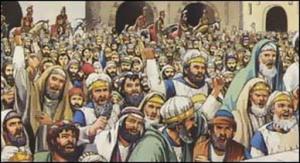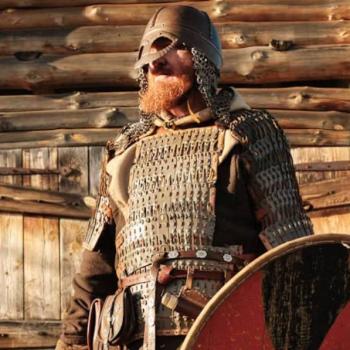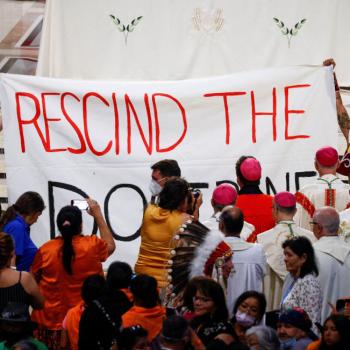
On Good Friday I stood with the congregation in church playing my part in the dramatization of the Passion story according to the Gospel of John. No need to identify the year; it was the same every year on Good Friday. We get to the part where Pilate presents Jesus to the crowd and I cry out along with everyone in the pews: CRUCIFY HIM, CRUCIFY HIM — just as that Gospel of John says the Jews cried out on the first Good Friday.
This emotionally disturbing part of the Good Friday enactment highlights my guilt, my role in Jesus’ crucifixion. I cannot do better than to refer you to Lindsey Paris-Lopez’ explanation in another Patheos post of that guilt that we share.
There’s another reason why this part of the passion story is disturbing. It’s the hard-to-avoid image of the Jewish people shouting for Jesus’ death and even overruling a supposedly reluctant Pilate. This image has been a spur to anti-Semitism through the Christian centuries. We need to be as clear as possible about the historical process that led to Jesus’ crucifixion. That process does not implicate crowds of Jews, either today or in first-century Palestine, for Jesus’ death.
Jews not to blame for Jesus’ death
In 1965 the Second Vatican Council declared that the Jews, whether of our time or of Jesus’ time, cannot be held responsible for Jesus’ death. Pope Benedict XVI repeated that teaching in his trilogy Jesus of Nazareth.
But every Good Friday we represent the Jews as ordering Pilate to crucify Jesus. As a Catholic, I think, we need to get to the point where we can say:
That episode in the Gospel of John, with Jews crying CRUCIFY HIM, didn’t happen.
We need to say it in church openly and not just hide it away in scholarly tomes and lectures in universities. Until we do, as a Church we’re contradicting ourselves and, worse, making it just a little easier for some to justify their continuing hatred of and violence toward Jews.
Scholars don’t just decide on personal preference whether something the Bible records did or didn’t happen. There’s a process to go through. It begins with understanding the situation of the Christian community up to the time the evangelists wrote. The Pontifical Biblical Commission has said, in the words of Raymond Brown,
… in the course of apostolic preaching and of Gospel writing, the memory of what happened in Jesus’ lifetime was affected by the life-situations of local Christian communities. (A Crucified Christ in Holy Week, p. 11)
So this attempt to be true to the history of Jesus’ crucifixion has to begin with a story about the early Church.
The life-situation of the early Church
Relations between the majority of Jews and the new Christian sect within Judaism were antagonistic. There were lots of sects in the Judaism of the first century. They disagreed with but tolerated each other. But Christians started singing hymns to Jesus “as to a God.” That’s how a Roman governor in the second century saw it. Presumably most Jews saw it that way too, and to them it was blasphemy.
Belief in one God was a marker of Jewish identity, a hard-won concept and one for which Jews of the vividly remembered past suffered and died. That was a line that no sect could cross, especially not one intent on winning other Jews over, as Jesus’ followers were.
Eventually the Christians, who had been participating in Jewish public worship as well as having services in their own homes, were shut out of Synagogue. That was a severe blow because the early followers of Jesus were Jews. They had no intention of starting a new religion.
This conflict was one factor influencing the perceptions of the first Christians, the way they told and retold Jesus’ story to each other. It affected the way Jesus’ encounters with his critics in those stories eventually got written down, especially that last, encounter that led crucifixion.
Life-situation, part 2
Another factor that influenced the way stories were remembered and passed on was the Roman Empire. Religion was an important part of that empire’s life, and non-conformity with religious customs was dangerous.
Jews were the only group that Rome exempted from laws requiring everyone to participate in Roman-style worship. To the Romans it didn’t matter what you believed as long as you bowed down at the right times in the right places. That was the way to be patriotic. Jews obstinately refused to do that, and practical Romans decided it wasn’t worth a fight. Besides, the whole world at that time felt a great deal of reverence for anything ancient, and the Jewish religion did have that going for it.
For Christians, however, it was another story. If the Jews disowned them, then they had lost their Jewish exemption. They certainly weren’t an ancient sect. Their place in the Empire was delicate and dangerous. It was important not to antagonize their Roman overlords.
Evolving stories: “Crucify him”
In combination, the conflict with the Jews and need to live with Rome led to a gradual shifting of blame for Jesus’ death from the Romans to the Jews. Stories don’t stay the same in the telling and retelling. Eventually, some of the Christians’ stories even depicted Pilate as trying without success to release Jesus. The rest of the world knew Pilate as a murderous tyrant who would have no scruples about sending a man to death. But Matthew’s Gospel has Pilate washing his hands of responsibility for Jesus’ blood while the Jewish crowds shouted, “His blood be on us and on our children!” (Matthew 27:24-25)
The truth is Pilate needed no encouragement at all to dispose of even the vaguest potential threat to stability in his realm. Very few Jews had any hand at all in Jesus’ death.
The most reasonable interpretations of that first “Good Friday” place the primary responsibility for Jesus’ execution on the Romans with some cooperation by Jewish authorities. There was no role at all for the general Jewish public except perhaps for one thing. They displayed way too much enthusiasm for the Messiah they seemed to see in Jesus. Crowds always made the Romans nervous; and that Palm Sunday crowd was especially boisterous.
The role of Jewish leaders
Jewish priests, scribes, Pharisees, and Sadducees shared the Romans’ desire to keep order. They would have had theological concerns about Jesus as well. In their eyes Jesus’ words and actions teetered on the edge of blasphemy, an offense for which the Jewish Law prescribed death.
The Gospels report one or two trials before a court of law. Was Jesus a blasphemer or not? The witnesses called could not agree. Was somebody acting as defense attorney? Jewish leaders wanted to get Jesus out of the way and thought they had good reasons within their own Law. At least they tried to follow that Law.
In the end it seems they gave up. It was a hung jury. Then comes what looks like a moral failure. They decided to send Jesus to Pilate. Knowing Pilate, they would have known they were sending Jesus to his death. There was no need to stir up crowds to ask for Barabbas instead of Jesus or shout: CRUCIFY HIM!
This way of describing Jesus’ trial is one of many attempts to answer the historical question, What events lead to Jesus’ death? One thing is clear: Blaming Jews in general, whether living today or in Jesus’ time, for Jesus’ death is without historical justification.
The more important question
Discovering the exact causes of Jesus’ death is less important to Christians than knowing what it means. The apostles struggled with that question. I’ve done my own struggling in a series of posts that I called “Opening the Scriptures on the Way to Emmaus.” Here’s how I concluded my feeble attempt. At church this afternoon, I’ll still be pondering the meaning of Jesus’ death and the goodness of Good Friday.
Image credit: Teach me the way O Lord, via Google Images












